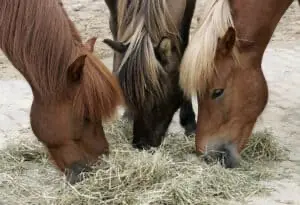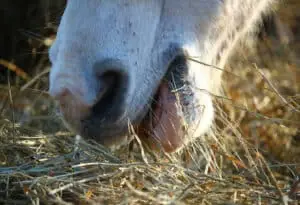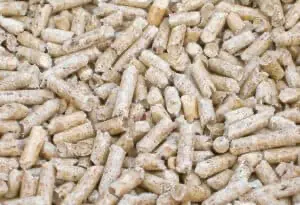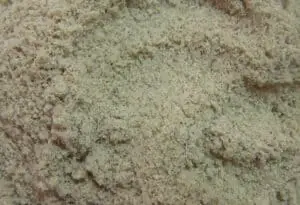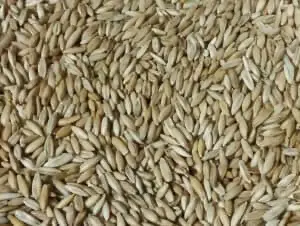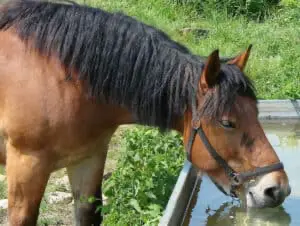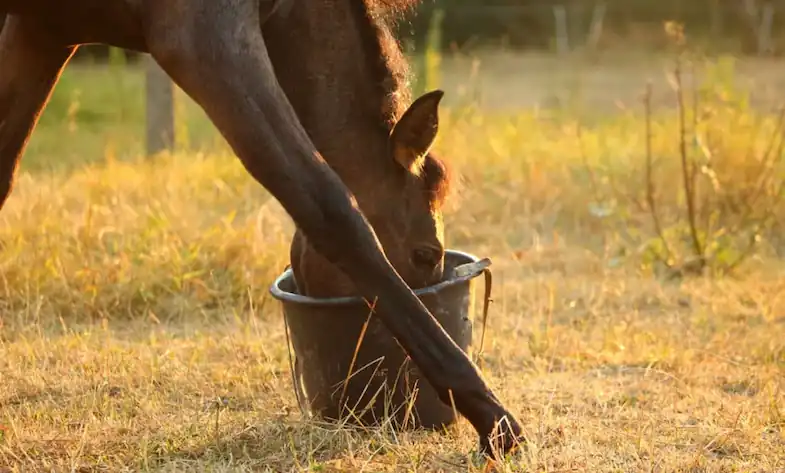When it comes to feeding a horse the most important thing to remember, regardless of what sort of food they’re eating, is to feed them little and often. Most horse owners (and enthusiasts) will have heard this at some point or other but it’s said for a good reason. Horses have a unique digestive system that requires them to have a high fiber diet that’s consumed in small amounts over a long period of time (rather than the larger meals we have).
Knowing how to feed your horse is only part of the battle, what you feed them is crucial. After all, being the herbivores that they are means that their digestive system isn’t designed to eat meat – even if your horse wolves down your ham sandwich. It can be difficult to know what the right feed for your horse is, especially if you’re a new owner. Every horse is different and every brand of food is different but if you understand what goes into a feed and what sort of nutrition your horse needs you can make an informed choice about what to feed him which is why I wanted to write this article.
What types of food your horse needs to eat
Typically the type of food that a horse needs is broken down into two groups, forage and concentrate.
Around 80% of your horse’s feed should be forage
Forage is part of a horse’s natural diet and generally used to describe grass (or pasture) and hay although it can also include things such as seed and nettles, as well as a few other foodstuffs that shouldn’t be fed to horses (things such as wild garlic). High-quality pasture will contain most of the nutrition that a horse needs to stay healthy but it also contains silica which helps to keep a horse’s teeth in great condition and generally aids good dental health.
While good quality pasture is always advisable it’s not as important as you might think in some cases. Of course, if your horse is a hard keeper then good pasture will give him the best nutrition (and the nutrition he needs), but if your horse is an easy keeper then you need to restrict his access to the best quality pasture due to the levels of sugar in it.
It’s worth noting though that wild and feral horses often have to make do with far less pasture that is also of a poorer quality yet they rarely suffer from issues that domestic horses do, issues such as obesity, laminitis, and EMS (equine metabolic syndrome).
You can use hay to top up the amount of pasture your horse consumes, or you could substitute some of the pasture for hay instead.
Approximately 20% of your horse’s feed should be concentrate
Concentrate can either be fed to your horse in pellet form, as a pre-made mix or you can mix the loose ingredients together yourself.
Pellets
Available in a variety of different combinations they normally contain compressed corn, supplements, salts, and various grains as well as molasses which can often be used as a sweetener and also as a binder.
Pellets can be used for all horses but also be made especially for certain types of horses such as pregnant mares, foals, performance horses, and senior horses.
Pre-mixed
Normally referred to as a concentrate mix, these contain a combination of different ingredients such as grains, flaxseed, beet pulp, molasses, bran, and vitamins and minerals amongst other ingredients. Pre-mixed concentrate feeds can be bought already mixed to a predetermined recipe or, if you have a large number of horses to feed, some feed mills will mix the feed especially for you and to your requirements.
Loose
If you prefer not to feed pellets or pre-mixed concentrates to your horse then you can always mix the ingredients yourself. This will give you full control of exactly what and how much you feed your horse. So if your horse performance horse that already has a lot of energy you can reduce high energy ingredients such as barley.
What to feed your horse
No two horses are the same and they all have their own nutritional needs which is why it helps to understand what different foods can offer, as well as what a horse needs day to day.
Forage
Around 80% of an average horse’s diet should be in the form of forage but there are a number of different types of forage available.
Grass
It goes without saying that, in most cases, grass is the most common form of forage but its quality changes throughout the year which is why it may often need to be topped up with other forage foods. If you’re living in an area without any grass (or with very little) then you’ll have to replace all of the grass with another form of forage.
Hay
Hay is used throughout the year to top up a horse’s forage although it’s important to make sure it’s of a high enough quality. You can (and should) have the hay regularly tested so that you know it’s exact vitamin and mineral values, this way you can compensate for any shortfalls. Just as is the case with grass, you should restrict the amount of hay easy feeders consume every day.
Straw
No, I haven’t gone mad and suddenly started talking about bedding, straw can actually be used in place of SOME of the hay. It’s low in protein and its fiber is indigestible which means that it’s highly suitable for easy keepers. Due to the indigestible nature of the fiber though, it can increase the risk of compact colic if too much is fed which is why it shouldn’t make up more than 30% of your horse’s forage intake (24% of their total daily diet).
Dried grass
We’re all told that you should never feed grass cuttings to horses and this is definitely true but dried grass is different. Its harvested early so is still very green but it’s then artificially dried to prevent the fermentation process from occurring. It’s high in protein and energy so is great for hard keepers but shouldn’t be fed to easy keepers.
Alfalfa
Like straw, alfalfa shouldn’t be used to completely replace hay or grass but should be used in combination with them. It’s high in calcium so is great if your horse is lacking that but if he isn’t then you should make sure his concentrate feed balances that out.
Short chopped fibre
Also known as chaff, it’s made from the dry and often scaly outer casing of cereal grain seeds such as rice, barley, and oats but it can also be made by finely chopping straw and hay into short lengths. It can be used to bulk up the feed of easy keepers or those on a low-calorie diet but is its nutritional content means that it can be used as a forage replacer for horses with dental problems.
High fibre cubes or pellets
Being made from hay, these cubes or pellets contain everything your horse needs, nutrition-wise, from his forage. The only problem with them though, in my opinion, is that grazing can help to keep a horse’s stress levels down. This is why I only feed cubes with hay and pasture as occasional treats – but that’s just me, from a nutritional point of view they’re perfect for horses.
Concentrate
When it comes to concentrate food it’s important to make sure your horse has the right balance of nutrition for his needs and workload. Horses don’t need as much concentrate as they forage which is why it only needs to make up around 20% of their daily feed.
Barley
Being very high in energy, barley often fed to performance horses although it can be difficult to digest so is often fed with bulkier feeds such as beet pulp, chaff, or chopped hay. If you’re feeding barley then it’s essential to measure it precisely, this is because even a small change in the amount fed can have a significant impact on a horse’s energy levels.
Rice bran
Like barley, rice bran, which is the byproduct of the milling process when brown rice is converted to white rice, is very high in energy although it also contains a good balance of carbohydrates as well as phosphorus and vitamin E. Its often used to increase a horse’s performance and endurance but can also be used for weight gain. Unlike wheat (or miller’s) bran, rice bran won’t cause a mineral imbalance in horses.
Grain mix
Sometimes called cereal grain, it’s classed as any grass that is grown for food but when it comes to horse feed it normally means corn, oats, and barley although it can also contain wheat, rice, and rye. They can be fed separately or as a balanced mix that contains a lot of the nutrition your horse needs.
Beet pulp
Most people choose to soak the beet pulp for around 12 hours before feeding it but it can also be served dry. Regardless of how you choose to feed it it’s high in protein, carbohydrates, and energy and is typically fed to horses that are on a heavy workload or are hard keepers, although that said it can also be used to bulk up foods that are difficult to digest such as barley.
Molasses
Being high in sugar molasses is often referred to as a source of fast energy for horses although it also has a lot of potassium so will help to keep your horse’s muscles working (and his heart-healthy). Molasses can also be used to bind food together as well as to make food such as barley more digestible. Horses are very similar to us when it comes to having a sweet tooth so you can also use a little bit of molasses to make your horse’s feed sweeter tasting and more appealing if they’re fussy eaters.
Flaxseed
Often mixed with other foods, flaxseed is very high in protein as well as being great for the digestive system. It’s rich in omega-3 which helps to increase the microbial bacteria in the large intestine, this in turn helps your horse to digest his food and therefore reduce the chances of suffering from colic.
Corn
There’s been a lot of talk recently about whether or not corn is okay to feed to horses but, in moderation, it’s perfectly okay. Corn has at least twice as much energy as oats do but because of the amount of starch it can be difficult for the horse to digest properly which ultimately can cause colic and in some cases founder. If you do feed your horse corn make sure you do it in small amounts and with other more digestible foods.
Oats
Unlike other grains such as barley and corn, oats are lower in energy while being high in fiber. This means that they’re not ‘heating feeds’ so won’t make your horse too excitable. For centuries oats was the stable feed for many horses because of its fiber and energy levels, that said though it should be fed as part of a balanced diet.
Salts and minerals
Many concentrates, especially those in pellet form or that are pre-mixed, already have salts and minerals included but if you’re only feeding your horse forage then you’ll need to either provide them with a salt block (or lick) or add loose salt to their diet (which can be added to their water).
If you opt for a salt block or lick then you need to make sure it’s suitable for horses because they have softer tongues than a lot of other grazing animals. Many salt blocks are designed with cattle (which have far rougher and tougher tongues than horses) in mind. While horses are okay to use these blocks, over time they can damage their delicate tongues. I personally prefer to use the Likit system (available on Amazon) because it’s not only been designed especially for horses but can also help to alleviate stress and boredom plus they also do a Himalayan rock salt block for it (again on Amazon).
Treats
There’s nothing wrong with feeding your horse treats now and then, after all, would you want to go without your favorite candy bar! That said though moderation is key here, don’t feed them lots of unhealthy treats (such as mints) too often. Even when you do feed healthy treats, such as apples, bananas, and watermelon it’s important to only give them a small amount each time. Feeding too much will not only alter your horse’s intake of nutrients but it could also put them off of their regular feed.
Water
Okay, I know water isn’t a type of food (even when it’s frozen) but it’s so important to a horse’s diet that I felt I couldn’t leave it off of the list. As well as helping with their kidney function (along with assisting with other bodily functions) it can also help them to digest their food.
Depending on the time of year horses can get a lot of water from their pasture but you should still provide your horse with plenty of fresh water every day.
Equine nutritional requirements: how much your horse needs every day
In order to know how much nutrition your horse needs you’ll have to take their workload, age, and general condition into account but the tables below will help to give you an idea of what an ‘average’ horse needs.
Minimum nutritional requirements for a horse
| Horse | Digestible energy (Mcal/kg) | Digestible energy (Mcal/lb) | Concentrate (%) | Forage (%) | Protein (%) | Lysine (%) | Calcium (%) | Phosphorus (%) | Magnesium (%) | Potassium (%) |
| At rest | 2 | 0.9 | 0 | 100 | 8 | 0.28 | 0.24 | 0.17 | 0.09 | 0.3 |
| Light work | 2.7 | 1.3 | 35 | 65 | 9.8 | 0.35 | 0.30 | 0.22 | 0.11 | 0.37 |
| Medium work | 2.9 | 1.32 | 50 | 50 | 10.4 | 0.37 | 0.31 | 0.23 | 0.12 | 0.39 |
| Heavy work | 3.14 | 1.43 | 65 | 35 | 11.4 | 0.40 | 0.35 | 0.25 | 0.13 | 0.43 |
| Pregnant mare | 2.33 | 1 | 25 | 75 | 10 | 0.36 | 0.44 | 0.33 | 0.11 | 0.37 |
| Lactating mare | 2.78 | 1.34 | 42 | 58 | 12 | 0.42 | 0.41 | 0.28 | 0.09 | 0.38 |
| Stallion | 2.4 | 1.1 | 30 | 70 | 9.6 | 0.34 | 0.29 | 0.21 | 0.11 | 0.36 |
| Weanling | 2.9 | 1.4 | 70 | 30 | 14.5 | 0.61 | 0.58 | 0.34 | 0.08 | 0.30 |
| Yearling | 2.65 | 1.20 | 50 | 50 | 12.3 | 0.51 | 0.39 | 0.19 | 0.08 | 0.30 |
| 2 year old | 2.55 | 1.15 | 50 | 50 | 10.9 | 0.43 | 0.32 | 0.18 | 0.09 | 0.31 |
Vitamin requirements for horses
| Vitamins | In rest | Working horse | Broodmare / Stallion | Foal / Filly / Colt | Maximum amount |
| A (iu/kg) | 3,000 | 4,000 | 6,000 | 3,000 | 16,000 |
| D (iu/kg) | 300 | 300 | 600 | 800 | 2,200 |
| E (iu/kg) | 50 | 80 | 80 | 80 | 1,000 |
| Thiamin (mg/kg) | 3 | 5 | 3 | 3 | 3,000 |
| Riboflavin (mg/kg) | 2 | 2 | 2 | 2 | – |
Mineral requirements for horses
| Minerals | In rest | Working horse | Broodmare / Stallion | Foal / Filly / Colt | Maximum amount |
| Sodium (%) | 0.10 | 0.30 | 0.10 | 0.10 | 3 |
| Sulfur (%) | 0.15 | 0.15 | 0.15 | 0.15 | 1.25 |
| Iron (%) | 40 | 40 | 50 | 50 | 1,000 |
| Manganese (mg/kg) | 40 | 40 | 40 | 40 | 1,000 |
| Copper (mg/kg) | 15 | 15 | 35 | 50 | 800 |
| Zinc (mg/kg) | 60 | 60 | 140 | 200 | 500 |
| Selenium (mg/kg) | 0.1 | 0.1 | 0.1 | 0.1 | 2 |
| Iodine (mg/kg) | 0.1 | 0.1 | 0.1 | 0.1 | 5 |
| Cobalt (mg/kg) | 0.1 | 0.1 | 0.1 | 0.1 | 1 |
Expected forage to concentrate ratio for horses (per % of total body weight)
| Horse | Concentrate | Forage | Total |
| At rest | 0 – 0.5 | 1.5 – 2 | 1.5 – 2 |
| Light work | 0.5 – 1 | 1 – 2 | 1.5 – 2.5 |
| Medium work | 0.75 – 1.5 | 1 – 2 | 1.75 – 2.5 |
| Heavy work | 1 – 2 | 0.75 – 1.5 | 2 – 2.5 |
| Pregnant mare | 0.5 – 1 | 1 – 1.5 | 1.5 – 2 |
| Lactating mare | 0.5 – 2 | 1 – 2 | 2 – 3 |
| Stallion | 0.5 – 1 | 1 – 1.5 | 1.5 – 2 |
| Weanling | 1 – 3 | 0 – 1.5 | 1 – 3.5 |
| Yearling | 1 – 2 | 1 – 1.5 | 1 – 3.5 |
| 2 year old | 1 – 1.5 | 1 – 1.5 | 2 – 2.5 |
Disclaimer: I’m not a qualified equine nutritionist but I have been a horse owner for many decades and while I don’t have any qualifications in this field I do have a lot of experience. That said though, the idea of this article is to help inform you about what your horse needs so that you can make a better decision. If your nutritionist or veterinarian says your horse should be eating something in particular you should always take their advice. Not only are they qualified but they also know and understand your horse better than any article ever could.
Further reading
- Can horses eat watermelon?
- Are horses okay eating bananas?
- How coconut oil benefits horses
- Surprising foods your horse should eat
- How much should my horse weigh?
- Feeding a hard keeper on a budget
- Do horses really need supplements?
- How t help your horse lose weight
- Why do horses eat mud?
- Things you should never feed horses
I hope you found this article helpful. If you did I’d be grateful if you could share it please as it would really help me.
Recommended products
Over the years I have tried hundreds of different horsey products, from various blankets and halters to different treats. Some I’ve loved, others I’ve hated but I thought I’d share with you my top all-time favorite products, the ones I never leave the yard without. I’ve included links to the products (which are in no particular order) that I really think are great.
- Horse Knots by Reference Ready – If you’re like me and enjoy pocket reference guides then you’ll love this knot tying guide. These handy cards can easily fit in your pocket or attach to the saddle for quick reference. They’re waterproof, durable and are color coded to make them easy to follow.
- Mane ’n Tail Detangler – Even if you never show your horse you’ll need to detangle his tail from time to time (and possibly his mane too) which is always a challenging chore! I’ve found that if I run a little bit of detangler through my horse’s tails every few days it stops them from getting matted up and makes combing them easy, even if they’re coated in mud. I don’t know if I should admit to this or not but it also works wonders on my hair.
- TAKEKIT Pro clippers – Over the years I’ve tried a lot of different clippers and while some were obviously better than others I found these to be by far the best. They are heavier than a lot of other clippers but for me, that’s a good thing, it makes them feel more sturdy and hardwearing. On top of that they have a range of speeds so are just as good for clipping your horse’s back as they are his face. I also like the fact that they come in a handy carry case but that’s not for everybody. The company that makes them is super good and incredibly helpful too, a real bonus these days. The only thing I wasn’t keen on was the fact that it doesn’t come with any oil, but that’s not a major problem as it’s not difficult to buy lubricant.
- Shire’s ball feeder – There are so many boredom buster toys out there but I like to use these every day, regardless of whether or not my horses are bored. I find that it helps to encourage my horses to problem solve by rewarding them with treats (or pieces of fruit) but it also mimics their natural grazing behavior which helps to keep them calm and de-stressed.
- Horse safe mirror – This is a strange one that many people are surprised about but I like to put horse safe mirrors in the trailers as well as in the quarantine stalls. It helps to prevent the feeling of isolation by giving the impression of other horses being around. Being herd animals horses can get extremely stressed when they feel that they’re on their own but with these stick-on mirrors, they believe that at least one other horse is with them.
- Rectal thermometer – I know this isn’t glamourous at all but it’s vital for your horse’s well-being to be able to check their temperature and a rectal thermometer is the easiest way of doing this which is why I’ve added it to the list.
Shopping lists
I’ve also put together a few shopping lists of essential items that I’ve found helpful over the years. I’ve broken the lists down into different categories rather than put everything in one massive list 😉

